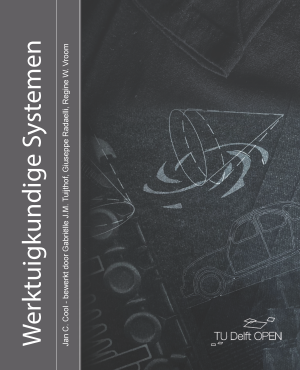Werktuigkundige Systemen
Keywords:
Werktuigbouwkunde, Systeemleer, Modelvorming, WerkingsprincipesSynopsis
Het boek Werktuigkundige Systemen is een compacte inleiding op het systeemdenken in de werktuigbouwkunde, met nadruk op inzicht en grafische methoden, gelardeerd met prikkelende werkingsprincipes en constructie-elementen. Velen merken dat ze nog lang nadat ze het vak gedaan hebben dit boek als naslagwerk gebruiken en het steeds meer gaan waarderen, ook omdat het boek de basis legt voor veel vervolgvakken en projecten.
Het boek is al jarenlang in gebruik bij eerstejaars studenten Werktuigbouwkunde aan de TU Delft. Diverse docenten gebruiken het bij vakken of ontwerpprojecten.
De oorsprong van dit boek in de tachtiger jaren is een college geweest, waarin op eenvoudige wijze de werking van bestaande apparaten en machines werd geanalyseerd. In een later stadium is deze stof uitgebreid met een aantal constructieve bijzonderheden. Daarbij heeft de systeemleer en de modelvorming een belangrijke basis gevormd.
Meer uitgebreid: De fundamentele principes bij ontwerpen komen in dit boek ‘Werktuigkundige Systemen’ naar voren. Zo wordt de systeemleer toegepast op werktuigkundige constructies en wordt in het hoofdstuk over modelvorming de weg aangegeven om de complexe fysische werkelijkheid om te zetten in een overzichtelijk werkingsinzicht. Ook onder meer mechanische versterkers komen aan bod en is een hoofdstuk gewijd aan de belangrijke begrippen sterkte en stijfheid. Er is ruim aandacht gegeven aan wrijving en weerstand, alsmede aan de middelen om deze te vergroten of te verkleinen. Omdat veren tot de essentiële werktuigonderdelen behoren is een hoofdstuk gewijd aan de toepassing van veren in een ontwerp. Hier is het belangrijke begrip voorspanning behandeld. Het onderwerp Aandrijving wordt behandeld en daarin wordt aangegeven op welke wijze een motor met een last moet worden gekoppeld. Het hoofdstuk over comparalogie laat de problemen zien bij het verkleinen of vergroten van reeds bestaande constructies en bij de vaak noodzakelijke modelproeven. Het hoofdstuk over energie ten slotte, geeft een inleiding in de ‘warme werktuigbouwkunde’. Hierin is een technologisch rendement beschreven dat aangeeft in welke mate een machine warmtetechnisch goed is geconstrueerd.
Dit boek kan gebruikt worden bij verschillende soorten technisch hoger onderwijs; zowel door het globale overzicht van de gehele werktuigbouwkunde, de introductie van systeemleer en modelvorming, als door de specialistische behandeling van enkele bijzondere onderwerpen.
The book Werktuigkundige Systemen is a compact introduction to systems thinking in mechanical engineering, emphasising insight and graphical methods, with tantalising working principles and construction elements.
The origin of this book in the 1980s was a lecture in which the operation of existing devices and machines was analysed in a simple way. At a later stage, this material was expanded to include some structural details. In doing so, systems theory and modelling formed an essential basis.
The book has been used by first-year mechanical engineering students at TU Delft for many years. Various lecturers use it in courses or design projects.
Many find that they continue to use this book as a reference book long after they have done the course and come to appreciate it more and more because it lays the foundation for many follow-up courses and projects.
More comprehensive: The fundamental principles in design emerge in the book Werktuigkundige Systemen. For instance, systems theory is applied to mechanical structures, and the chapter on modelling shows how to convert the complex physical reality into clear engineering principles. Mechanical amplifiers are covered, and a chapter is devoted to the essential concepts of strength and stiffness. Ample attention has been given to friction and resistance, as well as the means to increase or decrease them. Since springs are amongst the essential constructive components, a chapter has been devoted to the application of springs in a design. Here, the important concept of preload is covered. The subject of transmission is dealt with, in which the way to couple a motor with a load is indicated. The chapter on comparalogy shows the problems of scaling of pre-existing structures, needed to perform more affordable physical tests. Finally, the chapter on energy provides an introduction to “thermodynamics”. In it, engineering efficiency is introduced to indicate to what extent a machine is able to transmit energy into mechanical energy.
This book can be used in various types of higher engineering education, both because of the global overview on mechanical engineering, the introduction of systems theory and modelling, and the detailed elaboration of some typical mechanical engineering topics.
Downloads
References
Ansys GRANTA EduPack software, ANSYS, Inc., Cambridge, UK, 2014-2020 (www.ansys.com/materials), Reference Type: Database.
Anthierens, D., Inleiding tot de materialenleer, 2 delen, De Sikkel n.v., 1982 1.Struktuur en bereiding 2.Eigenschappen en vormgeving
Ashby M., Shercliff H., Cebon D.,Materials - Engineering Science Processing and Design. Oxford, UK: Butterworth-Heinemann, 2010.
Barret, C.R., Nix, W.D., Tetelman, A.S., The Principles of Engineering Materials, Prentice Hall, 1973
Binnendijk, S., Sterkteleer, Technische Uitgeverij H. Stam n.v., 1968.
Bouwman, L.P., Het aandraaien van bouten, Staalcentrum Nederland/Staalbouwkundig Genootschap, 1981.
Burr, A.H., Mechanical Analysis and Design, Elsevier, New York, 1985
Davis AK, Attarha B, Piefke TJ. Measuring the strength of the horned passalus beetle, Odontotaenius disjunctus: Revisiting an old topic with modern technology. Journal of Insect Science 2013 Oct 22;13. https://doi.org/10.1673/031.013.10701
Grieve, D.J., Springs, Reference Type: Online Source:https://mechengdesign.co.uk/PlannedWeb/springs/SpringsOrig1.htm, 22-3-2001 (re-vised 2010), view date: 5-5-2015 and 18-7-2022).
Grootkeukenstore. Reference type: Online source:http://www.grootkeukenstore.nl/horeca-vrieskast. View date: 27-04-2015.
Gukhman, A.A.,Introduction to the theory of similarity, Academic Press, 1965.
Henze A, Schroeder W. High performance vehicles. 2015. RWTH Aachen University. View date: 27-4-2015. Online Source:http://www.aia.rwth-aachen.de/vlueb/vl/fahrzeug-undwindradaerodynamik/material/Highperformancevehiclesenglish.pdf
Holmes, R., The characteristics of mechanical engineering systems, University of Sussex, Pergamon Press, 1977.
Hubka, V., Andreasen, M.M., Eder, W.E., Practical studies in systematic design, Butterworth, 1988
Juvinall, R.C., Fundamentals of machine component design, John Wiley, 1983. https://doi.org/10.1115/1.3258522
Kabus, K., Mechanik und Festigkeitslehre, Carl Hanser Verlag, 1973
McMahon, T.A., Bonner, J.T.,On size and life, W.H. Freeman and Company, New York, 1983
Meriam, J.L., Engineering Mechanics, 2 delen, John Wiley, 1980-2003. 1.Statics 2.Dynamics
Molian, S., Mechanism design, Cambridge University Press, 1982.
Morrison, D., Engineering Design, McGraw-Hill, 1968.
Nederlands Normalisatie Instituut, Normen voor Werktuigbouwkunde, NEN-bundel 1, Nederlands Normalisatie Instituut, Delft.
Pawlowski, J.,Die Ahnlichkeitstheorie in der physikalisch-technischen Forschung, Springer, 1971. https://doi.org/10.1007/978-3-642-65095-6
Ringhandt, H., Feinwerkelemente, Carl Hauser Verlag, 1974.
Rolls-Royce Power Systems AG. Diesel Engines Overview. View date: 27-4-2015. Online Source: http://www.mtu-online.com/mtu/products/diesel-engines-overview
Rosenthal, D., Asimow, R.M., Introduction to properties of materials, Van Nostrand Reinhold, 1971.
Schmidt-Nielsen K. Animal physiology. Prentice-Hall; 1960.
Shigley, J.E., Kicker, J.J., Theory of machines and mechanisms, McGraw-Hill, 1980
Smith, K., Mechanical and Engineering Principles, Volume 1, Pitman Education Ltd., 1981.
Trylinski, W., Fine mechanisms and precision instruments, Pergamon Press, 1971.
Wyatt, O.H., Dew-Hughes, D., Metals, Ceramics and Polymers, Cambridge University Press, 1974.





